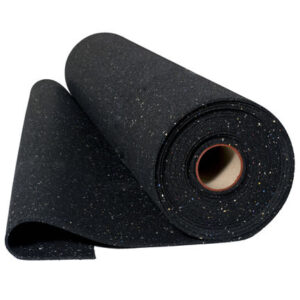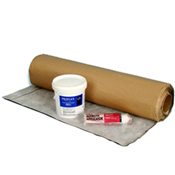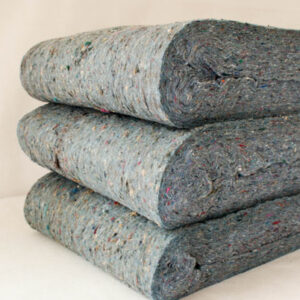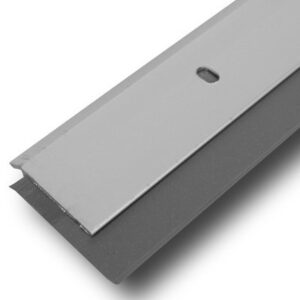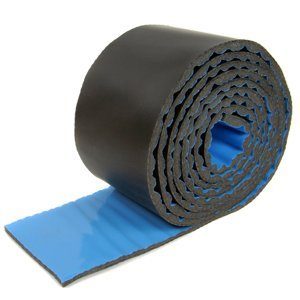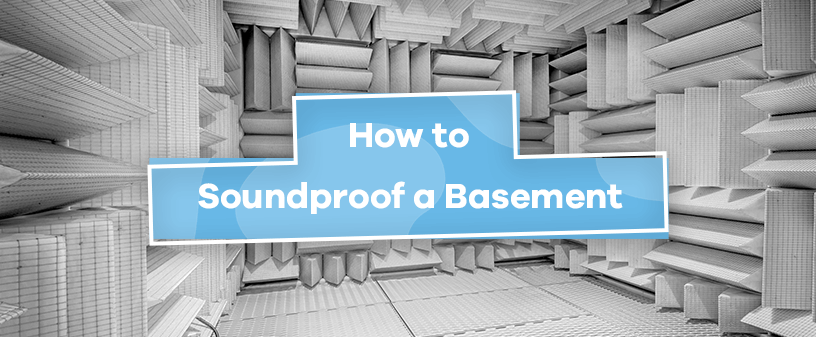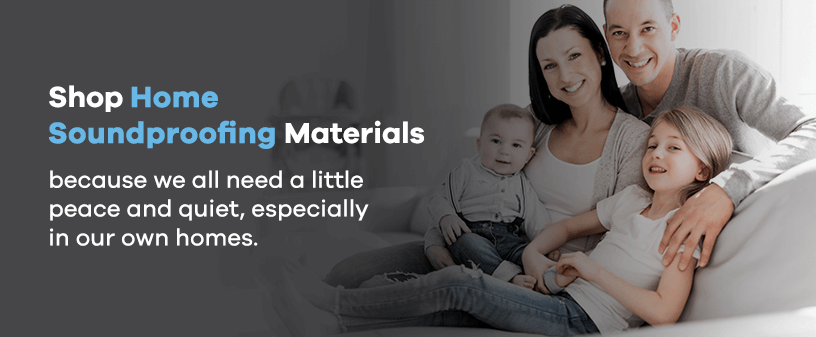
Basement Soundproofing Products
You can’t snap your fingers and silence your kid’s drum lesson, and you can’t mute the construction noises from your neighbor’s new garage. However, you can turn your basement into a soundproof oasis that’s perfect for those peaceful, quiet and calming moments we all need.
Use these basement noise reduction tips, tricks and products to determine the best way to soundproof your basement. Then sit back and enjoy the silence — you’ve earned it.
Areas to Soundproof in Your Basement
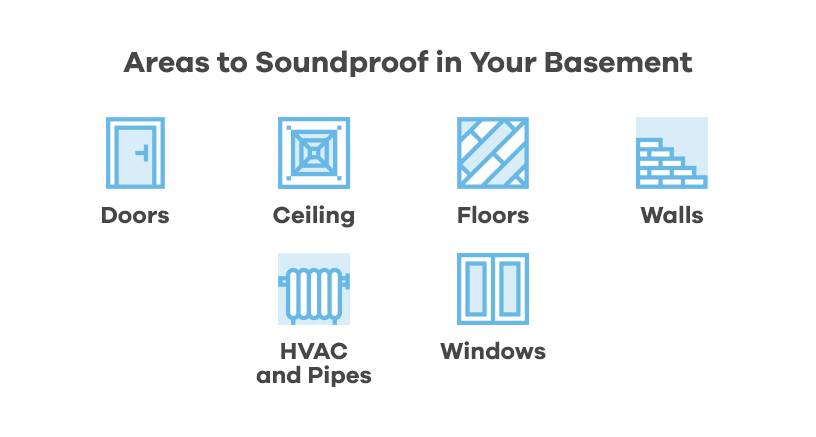
1. Basement Ceiling
Basement ceilings are a common sound contributor. Given your basement’s underground location, it’s susceptible to large amounts of mechanically transmitted sounds — for example, vibration-based noises such as footsteps or dropped items.
Mechanically transmitted sounds must travel through physical structures or objects. Basement ceilings, beams, and other overhead supportive structures provide the perfect conduit for this noise category and, therefore, need unique solutions addressing sound insulation.
How to Soundproof a Basement Ceiling
When it’s time to soundproof your basement’s ceiling, ensure you follow proper protocols and use the right tools and materials for a successful installation. Here are some general steps and tips for soundproofing the ceiling in your basement:
- Seal cracks, gaps or holes in the subfloor: To begin, you must seal the cracks, gaps and holes in the subfloor above your basement. Doing so prepares the surface while also making sure minute crevices won’t allow noises to sneak into the basement.
- Add mass: Adding mass is a significant component of soundproofing basement ceilings, so one of the first steps you want to take is introducing new layers of material like insulation, mass loaded vinyl (MLV) and drywall.
- Install soundproofing panels: Consider installing soundproof panels for extra security. The panels help reduce noise by absorbing and reflecting sound.
2. Doors
Doors are one of the most convenient places to begin when soundproofing your home’s basement.
Simply closing your doors is not enough to stop airborne distractions such as conversations, music, radio, television, traffic, pets and more. A soundproofed basement door prevents these noises from infiltrating the space, which creates that ideal quiet reprieve. Plus, many soundproof basement door products lend additional privacy — perfect if you’re setting up a home studio or office requiring minimal distractions.
To soundproof the doors to your basement, you could add door seals or sweeps to close the gap between the doors and the floors or staircase. Door sweeps and seals consist of solid, dense rubber, making it hard for sound waves to move through them. You could also add soundproofing foam on or around the doors to help block sound from entering the basement. Putting soundproofing materials on the walls and areas surrounding the basement door adds an extra level of noise reduction.
Shop Door Soundproofing Materials
3. Floors
Unfinished basements with concrete slabs as flooring are susceptible to higher sound transmission. This happens because sound waves — airborne, mechanical, etc. — hit and reflect off such surfaces, becoming auditory vibrations that increase the entire space’s noise levels.
Other types of hard flooring function the same way, contributing to noise pollution rather than reducing it. The basement may be the lowest point in the house, but a noisy floor in this area still results in more unwanted sound than is desirable. To remedy this issue, consider installing absorption foam between the concrete and the final floor finish to ensure your basement floors have proper soundproofing. Additionally, you could place some flooring underlayments under carpets or rugs to reduce and absorb noise.
4. Walls
Basement walls are another important layer to integrate into your sound insulation plan. Walls are notorious for transmitting flanking noises — or sounds that travel indirectly through wall joists, ductwork, boards and wall layers. Adding soundproofing boards and materials on top of or into basement walls minimizes flanking and mechanical noises. Even small sound barriers less than a half-inch thick can go a long way in basement soundproofing for finished or unfinished rooms.
If you’re constructing walls in your basement to create separate rooms, you could follow the decoupling process to prevent noise transfer to and from each room. With decoupling, you can take advantage of sound isolation systems. For more soundproofing, consider decorating your basement walls with acoustic panels personalized with art, fabric or perforated wood. If you live in a warmer climate and your basement is prone to humidity, consider installing water-resistant acoustic panels for the best possible performance.
5. HVAC and Pipes
Your home’s pipe and ductwork systems may be a contributing factor to your sound issues. Consider the positioning of mounted air conditioners, plumbing pipes, furnaces, exposed ducts and more. And remember to consider how reverberations from each of these transfer through basement walls and ceilings. By insulating pipework, you address sounds at the source before they can infiltrate other areas of the home.
For extra noise reduction, you can also cover pipes and your HVAC system areas with MLV barriers — these thin, flexible soundproofing materials are perfect for numerous applications. Another way to lessen noise is by filling the spaces between the wall and pipes with different soundproofing materials to make the pipes quieter.
How to Soundproof Your Basement
Now that you know some of the primary sources of basement sound, it’s time to silence them for good. Follow this guide when determining the best way to soundproof your basement:
1. Plan Ahead & Map Out Your Basement
Any home project requires a little foresight before diving in, like adding sound-absorbing insulation or sound-deflecting products to your basement.
Start by inspecting your basement’s piping, walls, doorways, ceiling, flooring and windows. Pay special attention to areas where cabling or HVAC components are currently installed, as well as electrical wiring. You’ll need to take extra care when installing insulating materials near these spots. Then, compile accurate measurements of basement features where you’ll likely implement soundproofing materials, including door frames, windows, wall beams and piping.
2. Start Small And Soundproof With Acoustic Caulking
The secret to soundproofing any room is making it as airtight as possible. Even the smallest holes or gaps contribute to sound transmission.
Start on your basement soundproofing project by tackling these minor sound-spot treatments. You can do this by applying sound-reducing or acoustic caulk across the following:
- Cracks or gaps in doorways
- Cracks or gaps in window ledges and surrounding window frames
- Cracks or gaps in exposed single or double drywall, as well as walls
- Holes or gaps surrounding wiring, cables and pipework
- Joist openings
- Any miscellaneous, sealable cracks found in your basement
Sealing these areas sets you on the right path to a functionally soundproof basement. You can now graduate onto the next phase of your soundproofing strategies, which involve more advanced noise-reduction products.
3. Create Sound-Insulated Walls and Ceilings In Your Basement
Sometimes called “hushboards,” these sound-insulator products come explicitly designed for wall and ceiling applications. Installing various hushboard-like materials into your wall and ceiling systems is perhaps the most powerful weapon against sound transmission, creating the ultimate soundproof basement.
Sound-insulating hushboards and fiberboard work in two ways. First, they trap and contain noises originating in your basement. Second — and more importantly — they catch sounds from other parts of your home’s interior and exterior before they can contribute to basement noise pollution.
The best approach to creating sound-insulating walls and ceilings is to add soundproofing insulation barriers directly into or around these surfaces, depending on what your construction capabilities allow. Here are two ways to add sound insulation in your basement:
- Exterior framework insulation: Exterior insulation products apply to the outside face of existing basement walls and ceilings. These panels, foams and sheets sit exposed on your walls, absorbing sounds as well as providing thermal benefits. To hide them, you must construct and install a secondary wall adjacent to the insulation you just placed — which essentially requires creating a room within your existing one. Build room frames perfectly matching your basement’s dimensions, with their own single or double drywall layer, then seal that new wall against your existing ones while leaving room for vents, pipes and cabling.
- Interior drywall insulation: Conversely, insulation can be installed directly into current basement walls. This soundproofing method works best during current or ongoing home remodeling projects or as part of a total noise-reducing and sound-isolating system.
4. Address the Basement Doors
Doors may seem like a minor culprit in permitting noise transmission throughout your home. After all, how much sound can those tiny cracks along a door’s edge really contribute to basement noise pollution?
Properly soundproofing your basement requires addressing every possible weak spot — and that includes the basement’s main door, as well as any entrances in a multi-room or finished basement.
Install adhesive perimeter seals around all basement door frames, plus sweeps for each door’s base. These provide an airtight seal without inhibiting use of the door itself. For extra insulation, you may even consider hanging sound-absorbing foam, fiberglass or cotton boards and panels on doors.
5. Soundproof the Basement Ceiling
Finally, address the ceiling, which transmits most of the mechanical and vibration-based noises in your basement. Reduce these types of basement noises by using the following sound-absorbing methods:
- Applying foam, fiberglass, cotton or polyurethane acoustic panels directly onto ceilings works to reduce noise in most basements.
- Hanging ceiling baffles to absorb sounds further, this works best in large, open-concept basements with hard floors.
Note that a pure, exposed drywall ceiling will likely require insulation added into the drywall itself, which will call for removing all or part of it. Drop ceilings can have soundproofing elements installed into them relatively smoothly. An unfinished basement ceiling with ductwork, plumbing and exposed joists accommodates even more soundproofing products and options.
Soundproof Cow Products to Soundproof Your Basement
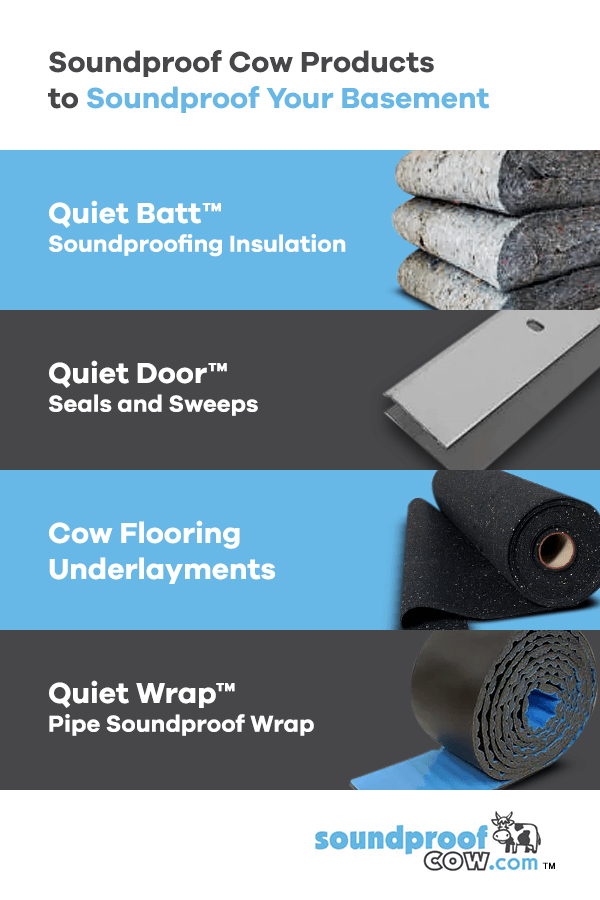
1. Quiet Batt® Soundproofing Insulation
Soundproof Cow’s Quiet Batt® Soundproofing Insulation is our premier thermal insulation product.
Fabricated from three inches of densely-packed, sound-dampening cotton fibers, Quiet Batt® works in both indoor and outdoor environments. Sheets of Quiet Batt® can be installed in basement interior walls and ceilings, with a tight but adaptive fit around studs, joists and more. It’s an ideal sound-absorbing solution that also provides additional thermal insulation — perfect for stand-alone installation in your basement’s walls and ceilings.
Plus, cotton-based Quiet Batt® Soundproofing Insulation requires only a basic utility knife to cut and trim — so installation is effortless.
2. Quiet Door™ Seals and Sweeps
Quiet Door™ seals and sweeps ensure you don’t overlook the basement doors in your DIY soundproofing project.
Soundproof Cow offers two lines of door soundproofing products that work on indoor and outdoor plastic, wood, metal and composite doors:
- Quiet Door™ Perimeter Seals: Quiet Door™ Perimeter Seals hug your door frame’s perimeter, with adjustable mounted knobs ensuring a snug final fit.
- Quiet Door™ Sweep: Quiet Door™ Sweeps sit at the base, or threshold, of your basement door. Installing a door sweep seals the part of your entryway that often has the largest gap, but it won’t make opening or closing the door difficult.
Soundproof Cow also offers residential soundproofing door kits with both sweeps, stops and other door-sealing tools in one product.
3. Cow Flooring Underlayments
All of Soundproof Cow’s floor underlayments are simple-to-install sheets with several advantages. They insulate noises and warm those notoriously cold basement floors while also providing a protective barrier against mold or mildew, which is particularly beneficial if your basement has carpeting.
Choose from two main varieties of underlayments depending on your basement’s floor type:
- PROFLEX™ 90: Our PROFLEX™ 90 underlayment fits beneath hard floor surfaces such as stone, tile or hardwood. If you’re looking for sound solutions for your finished basement floor, check out this special rubberized membrane sheet.
- Impact Barrier QT: Impact Barrier QTs are all-purpose floor underlayments. The half-inch thick material consists of 92% recycled tire rubber, which provides better sound reduction than other leading insulation materials like cork, felt and roofing membrane fibers. Install the Impact Barrier QT under basement carpet, vinyl, laminate, tile, hardwood, stone and more.
4. Quiet Wrap™ Pipe Soundproof Wrap
Complete your basement soundproofing with Quiet Wrap™ Pipe Soundproofing Wrap.
Many older homes experience loud clanking, whirring and sloshing noises from active pipes. Quiet Wrap™ Pipe Soundproofing Wrap’s industrial-grade foam composite provides a membrane-like fit around problematic pipes. The polyurethane foam composition is safe for pipe and duct environments up to 140°F and offers flame-resistance while lending great acoustic absorption.
The best time to sound-insulate pipes is during construction or home renovations, since this is when you have unimpeded access to your pipework. However, Quiet Wrap™ Pipe Soundproofing Wrap works just as well wrapped around exposed iron, copper and polyvinyl chloride (PVC) pipes to contain distracting noises.
Benefits of Soundproofing Your Basement
Basement soundproofing is much easier than people think. Plus, it brings several benefits for your home, health and — let’s face it — sanity. Here are some of the rewards you’ll reap from quieting the noise:
1. Reduced Noise Pollution
Noise pollution is an increasingly common side effect of living in a sound-saturated and overstimulated world. Prolonged exposure to continual noise has links to adverse health effects — particularly regular exposure to sharp sounds and bass frequencies, the latter of which is the hardest to soundproof.
Reducing your home’s noise pollution correlates with:
- Decreased stress and anxiety
- Better sleep
- Enhanced focus and concentration
- Improved memory
- Reduced risk for hearing loss or tinnitus
- Increased cardiovascular health
2. Increased High-Focus Space
Basement soundproofing allows you to create a purposefully quiet space in an isolated area of your home. Your basement stands out as a prime candidate for sound insulation and reduction because it’s already partially removed from other floors — and the hustle and bustle taking place within them.
For example, you can use the new quiet space in your basement as a revamped:
- Home office
- Home music or art studio
- Home gym
- Home theater
- Yoga or meditation room
All of these rooms’ activities function best with minimal disruptions. Soundproofing — delivered via sound-insulating or sound-absorbing wall, ceiling and door additions — will help increase concentration and focus within these basement rooms.
3. Improved Mental Health

4. Enhanced Insulation
Basements are notoriously poor insulators. If you live in a particularly cold part of the country, you know this all too well. Many basement soundproofing products and materials double as heat insulators, trapping and maintaining warm air in your basement. Alternatively, these same solutions can regulate summer temperatures, improving year-round insulation.
If the idea of a cozier basement isn’t motivation enough, consider how properly insulated rooms can save money on your energy bills — especially during winter. You can thank us later.
5. Reduced Stressors
Your home should feel like a source of respite. Even amidst the inevitable sounds, stressors and distractions of everyday life, soundproofing your basement provides a designated retreat for you and your family to slow — and calm — down.
Shop Basement Soundproofing Materials
Explore soundproofing products for residential doors, walls, ceilings, floors and more, all designed for easy installation and long-lasting application. Our history in acoustic insulation has equipped us with the knowledge and expertise necessary for creating effective soundproofing solutions.
Look through our selections and start planning your project to soundproof the basement today — because we all need a little peace and quiet, especially in our own homes.
Soundproof Other Spaces
Apartment Building
Auditorium
Band Practice
Bar & Lounge
Broadcast Studio
Cafeteria
Call Center
Church & Worship
Classroom
Clean Room
Condo & Townhouse
Conference Room
Dance Studio
Dog Kennel & Daycare
Equipment Room
Factory
Food Preparation Area
Food Processing Facility
Garage Band
Garage
Gun & Firing Range
Gymnasium
Home
Home Theater
Hotel Soundproofing
Library
Machine Shop
Manufacturing Facility
Mechanical Room
Music Room
Night Club
Office
Pool
Recording Studio
Restaurant
Server Room
Warehouse
Weight Room & Fitness Center
Workshop

I just wanted to let you know that in the end, sealing the air spaces on this door worked just fine and took care of the problem.
I really appreciate you taking so much time to share your expertise with me, and in particular recommending I try the simpler solution before investing in more expensive noise barriers. That is a big credit to you and your business.
- Mike

